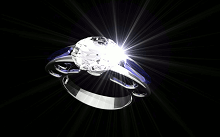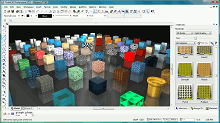Lighting & Materials in TurboCAD Windows
Materials
TurboCAD includes a robust material editor, and numerous shaders to create materials and their finishes with a real-time preview that is available even on a selection from the model instead of just a simple cube or sphere (also available). When creating or altering materials there are extensive descriptions of each shader in the dialog window to simplify each step.
Bitmap textures may be brought into TurboCAD and used as material textures. Included is support for transparency patterns. This can be useful for rendering of landscapes, as a 2D image of a tree, for example, can render much faster than a high-polygon 3D modeled tree with each leaf being calculated separately.
Lighting & Luminances
There is also robust support for lighting and luminances. Lights are OpenGL based, are quick to add and use. Lights may be added with a click, and their properties adjusted in the Design Director, which also enables creating light sets that can be turned on or off as a group. Light types include:
- Ambient
- Directional Light — has an origin and a direction, providing an infinite light that does not fade with distance
- Headlight — provides a Directional Light sourced at the camera source sot that it is always illuminating from the user's vantage point
- Point — provides light equally from all directions
- Spot Light — provides a directional light eminating from a point and projecting in a cone
- Sky Light — a simple directional light source that simulates outdoor sunlight
Each light has many different properties that can be managed, including the color; intensity; fall-off; shadow softness; and more. Some that are directional specific may include properties such as the beam sharpness, penubra and umbra (the angle of the cone of light and the darkness in the center of the beam, useful for flashlights). Luminances include advanced lighting properties that can be assigned to the whole model, or to specific objects within the model. Any number of lights may be combined, so that an Ambient luminance may be used, then augmented by other lights and luminances.
Luminances include advanced lighting properties that can be assigned to the whole model, or to specific objects within the model. Any number of lights may be combined, so that an Ambient luminance may be used, then augmented by other lights and luminances.
With each light and luminance there are numerous properties. Combine them effectively and the lighting possiblities are endless. Create natural lighting for various conditions, artificial lighting to simulate any environment necessary, or mood lighting to emphasize elements of a design and provide an impact. Lighting is a very powerful element in the design communication process.

